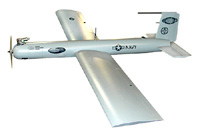
Smaller than the Predator and Global Hawk, the Office of Naval Research's unmanned aerial vehicle (UAV), Silver Fox, comes ready for the hunt.
The Silver Fox UAV has a 6-foot long fuselage with detachable 8-foot wide wings and tail fins that fit into a super-sized golf bag carrying case. Weighing only 20 pounds and powered by a model plan engine, it can soar upwards of a 1,000 feet and is equipped with state-of-the-art "eyes in the sky" camera technology.
Forward "eyes on the ground" give battle ready Marines intelligence about what lies ahead of their advance and makes them better prepared for an impending engagement. Marines at the tactical level needed a system to determine what lies beyond the next hill or hiding in an ambush position. The Office of Naval Research took that need to its Tech Solutions group and developed a workable solution in short order.
Tech Solutions teamed with Advanced Ceramics Research (ACR) of Tucson, Arizona, through the Small Business Innovation Research program and rapidly developed and deployed a new entry into the realm of UAVs. "The right talent from Marine Corps' Warfighting Lab, Naval Research Lab, Naval Post Graduate School, the Office of Naval Research, various defense contractors, and university researchers converged at ACR to rapidly make happen what absolutely had to happen," said Anthony Mulligan, CEO of Advanced Ceramics Research.
Built as a small tactical UAV, Silver Fox's 6-foot long fuselage, detachable 8-foot wide wings, and tail fins fit into a super-sized golf bag. Weighing only 20 pounds and powered by a model plane engine, Silver Fox can soar upwards of 1,000 feet. Equipped with state-of-the-art "eyes in the sky" camera technology, it flies autonomously using Global Position Satellite (GPS) as one of its navigational systems--making this a true hands-off aircraft.
Launched using a small compressed air powered launcher, Silver Fox employs high tech "eyes" and relays information instantaneously to a remote laptop computer providing intelligence for advancing Marines. It has a flight endurance of several hours that enables it to cover large areas of territory, uses combat aircraft avoidance protocols, and also has the payload capacity for other small, state-of-the-art detection systems. "Its size, portability, and aerial capabilities make it a tactical level leaders' clear cut option to gather battlefield intelligence," said Chief of Naval Research Rear Admiral Jay Cohen.
The Office of Naval Research and the ACR's response within a month resulted in the ability to provide operational systems to the Marine Corps to supplement needed reconnaissance capabilities in combat. "We sent an ONR team into the theater to deploy the Silver Fox following its transition from the original design," said Captain John Hobday, a naval reservist and director of Tech Solutions. Regarding its current mission, Rear Admiral Cohen said, "Silver Fox was designed to spot whales in operating areas to keep them out of harms way before conducting naval exercises. It's now being tasked to help our Marines on the ground."